
Cabaret at Cannes: thenetworkone Cannes Lions Review 2022

We can probably all remember Liza Minelli’s unforgettable rendition of the song:
“What good is sitting alone in your room? come hear the music play life is a cabaret, old chum come to the cabaret!”
And yes, a little like 1930’s Berlin, the storm clouds were gathering, not far away. The US Supreme 'Court', packed with political appointees, passed laws to repeal Roe v Wade; to protect the right of crazy people to carry sub-machine guns; and to promote the use of coal, one of the most polluting fossil fuels. Vladimir Putin’s Russia sent a missile into a shopping centre (or was it a hospital, or a theatre, or a school, or a care home?) to prove that Russia can do what it wants, to its close neighbours – and maybe not only to them.
But we needed a party, we needed the rose, we needed some music, we needed the cabaret. We needed to see old friends and make new ones. We needed the conversations on the Croisette, we needed the sunshine, and we needed the feeling of being pleased to see each other beyond the zoom screen.
So kudos to the Cannes organisers for making it happen – despite the uncertainties over covid, travel problems, political problems and everything else up until a few weeks before the show began. And for proving once and for all: the Carlton might still be closed for renovations, but it’s the people outside who matter.

So what was the vibe?
Cannes is a barometer of our industry – but this year, was much harder to read than normal. One of the problems with Cannes is that the lead times are long. Speakers have to submit proposals the previous year (this needs to change) and by definition, most of the work entered for awards, was produced the previous year also. So much has changed, that last year is old news, and a lot of the content and the work felt flat. 'Purpose fatigue' was a phrase used by many commentators, and it’s easy to see why.
Let’s start with the work and the awards, because that’s where the heart of Cannes traditionally lies.
The Awards
For many people, Cannes is about winning a Lion, the Oscar of the marketing and communications industry. And the statuettes that matter most are the Grand Prix’s, awarded for the single best entry in each of Cannes Lions’ 30 categories.
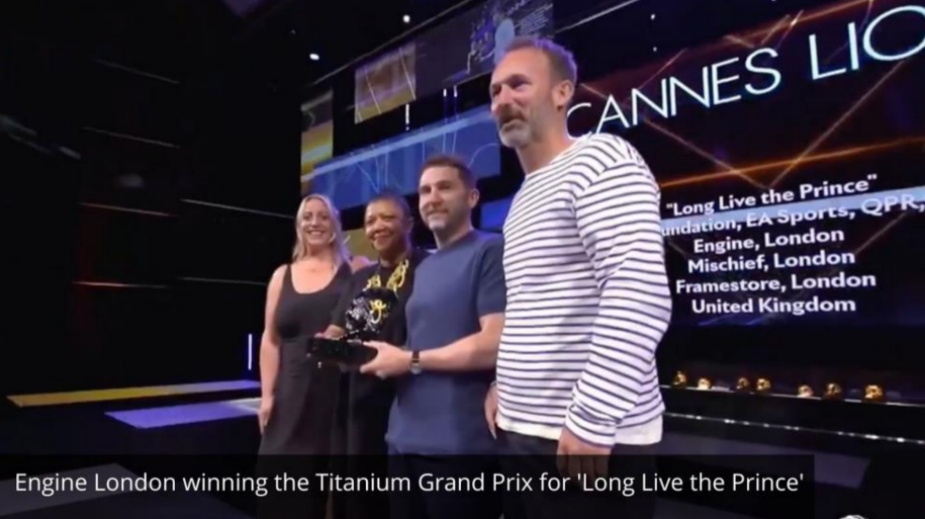
The Cannes Lions team now divides the award categories into nine groups. These are:
1) “Classic”: Film, Outdoor, Print and Publishing, Radio and Audio
2) “Craft”: Design, Digital Craft, Film Craft, Industry Craft
3) “Engagement”: Creative B2B, Creative Data, Direct, Media, PR
4) “Entertainment”: Entertainment, Entertainment for Music, Entertainment for Sport
5) “Experience”: Brand Experience and Activation, Creative Business Transformation, Creative Commerce, Innovation and Mobile
6) “Good”: Glass (as in ‘glass ceiling’), Grand prix for Good, UN Social Development Goals 7) “Health”: Health and Well-being, Health Grand Prix for Good, Pharma
8) “Strategy”: Creative Effectiveness, Creative Strategy
9) “Titanium”: a single category meaning ‘multi-channel’ or ‘multi-discipline’
The 'Classic' categories (four out of 30) represent what is left of ‘advertising’. Any readers over the age of 25 may remember that until quite recently, the Cannes Lions used to be called the Cannes Advertising Festival, and used to present prizes for advertising.
In 2019, Mr David Droga, the Cristiano Ronaldo of Advertising Creativity, took a look at a particularly hideous banner strung across the Carlton Hotel’s Second Empire style façade and told us from the Lumiere stage that people don’t like advertising any more. So the word has been officially banned in Cannes, and – like any Russians who refer to a certain special military operation as an invasion – anyone who uses the word ‘advertising’ will be sentenced to 15 years on a zoom call.

Whisper it quietly, but under cover of the private yachts hidden away in ‘Yacht Alley’ behind the Palais des Festivals, the same companies whose multi-billion dollar profits are driven by advertising (oops) are talking about a*********g quite a lot: but behind closed doors and guarded by security personnel, as a €3500 official delegate badge doesn’t get you in here.
Of course, Google, YouTube, Meta, Spotify, Comcast and the rest also have their party venues on the main beaches. They are best appreciated from the Croisette, where you can hear the music, see the performers on giant screens and have an audible conversation with friends at the same time. This is an example of ‘Engagement’, ‘Entertainment’ and ‘Experience’, which represent 14 out of 30 categories in the new world of Cannes awards.
So now we’ve explained the rules: who actually won the games?
Joking aside: it’s important to note, that almost no Grand Prix’s were awarded to entries whose principal objective was to advertise or sell a company’s products or services. I could only identify two:
- The “Direct” Grand Prix winner, Leo Burnett’s un-original story about a Junk-food company called Wingstop, which changed its name to Thighstop when it ran out of chicken wings
- The “Creative Commerce” winner from Accenture Song, selling Coinbase (a cryptocurrency) via a QR code moving across a Superbowl TV screen in the style of 1980’s tele-tennis (well that was one for the over-25s.)
Similarly: if not actually banned, humour was conspicuously absent from ALL the GP winning entries.
The weak effort by Apple (Film category winner, about a group of bored employees quitting their office jobs) – served only to remind us why Apple never uses humour in any of its communications.
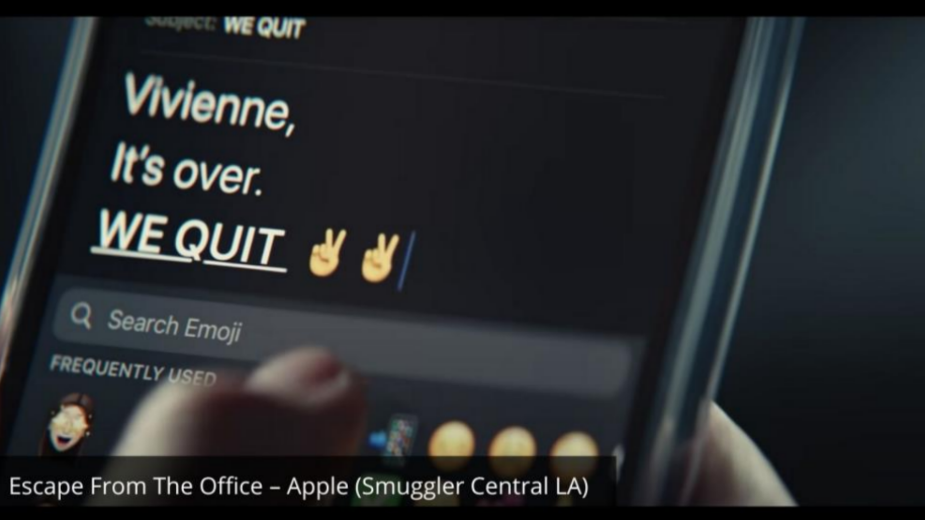
The Swedish Food Federation’s over-long rework of Jonathan Swift’s ‘A Modest Proposal’, advocating cannibalism, does not qualify either, because neither of them was funny.
As far as I remember, people who liked a*********g mostly liked it when it was funny, so at least the lack of humour is consistent with the unacceptability of advertising.
So with no advertising, and no humour – the judges mostly awarded entries for worthy causes and “purpose-driven” PR stories.
We had nicely crafted audio work supporting the restitution of looted historical artefacts, a book remembering the ousting of a Portuguese dictator, and well-meaning a/v content recognising the challenges of people with disabilities and mental health issues, advocating gender and economic inclusion, opposing testing products on animals, condemning cultural ethnic cleansing in Latin America, driving education about women’s health and nutrition issues, and highlighting the value of exercise bikes in Belgian prisons (a first world problem, that last one, and a highly questionable recipient of two Grand Prix’s).
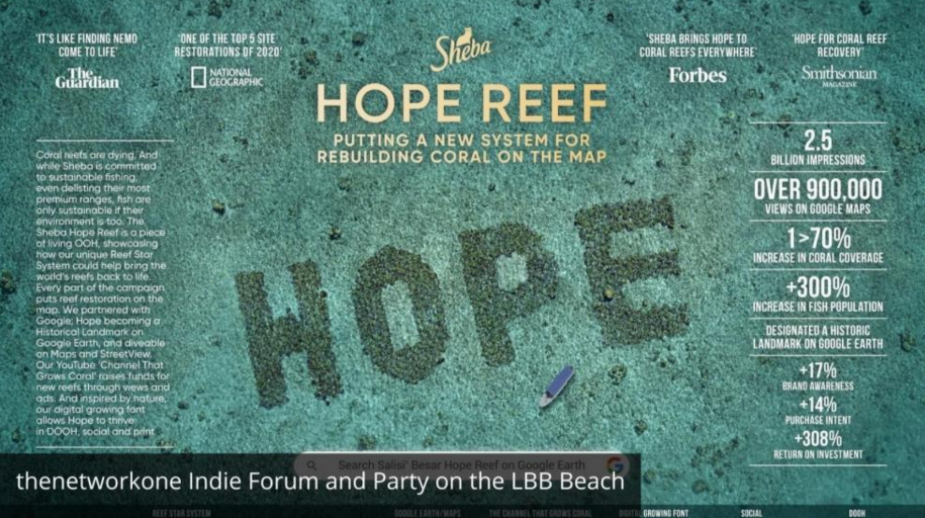
Personally, I thought the Hope Reef (by AMV BBDO in UK for Sheba cat food) was the worst example. You can see how they got there: Cats eat cat food > some cat food contains fish > some fish live on coral reefs > let’s save a coral reef > and make it the only coral reef big enough to be seen from space! (except we don’t have the budget for that, so let’s bung Google a few dollars and say it’s the only coral reef that can be seen on a Google map).
Unless of course, the real ‘Brand purpose’ of Sheba is not cat health and well-being (as I used to think) but the assuaging the guilt feelings of humans who imprison animals in their houses for their own pleasure, in which case a GP for Strategy might be appropriate, if a little cynical. But the Grand Prix for Media???
OMG, it is no wonder we all have 'purpose fatigue.'
That said, there were some really nice, original, effective, socially beneficial ideas as well. Interestingly, most of them were more to do with product design than communications.
For me, these were deservedly prize-winners:
- ‘Data Tienda’ by DDB Mexico for WE Capital, creating a credit history for ‘unbanked’ women in Colombia
- ‘Nike Sync’ by RG/A London for Nike, an app to optimise training for female athletes around their menstrual cycle
- ‘Realtone’ by Google in USA, to improve the quality of photography of People of Colour, compared to previous camera phone technology which was optimised for ‘white’ skin tones
- ‘Backup Ukraine’ by Polycam and Virtue Worldwide for Unesco, to create 3D records from amateur photographs of statues and artefacts in Ukraine under threat of destruction, from Russia’s special military operation
- ‘Piñatex’, by L&C New York For Dole Sunshine Company, creating an alternative to leather from Pineapple fibres which would have go to waste and caused pollution
- ‘I will always be me’ by VMLY&R New York, for Dell, creating voice bank records for Motor Neurone disease sufferers, so they can continue to talk using their own voices
- ‘The Killer Pack’ by VMLY&R Mumbai for Maxx Flash, a mosquito repellent for indoor use – creating packaging which also kills mosquitos in trash collection sites, where they usually breed
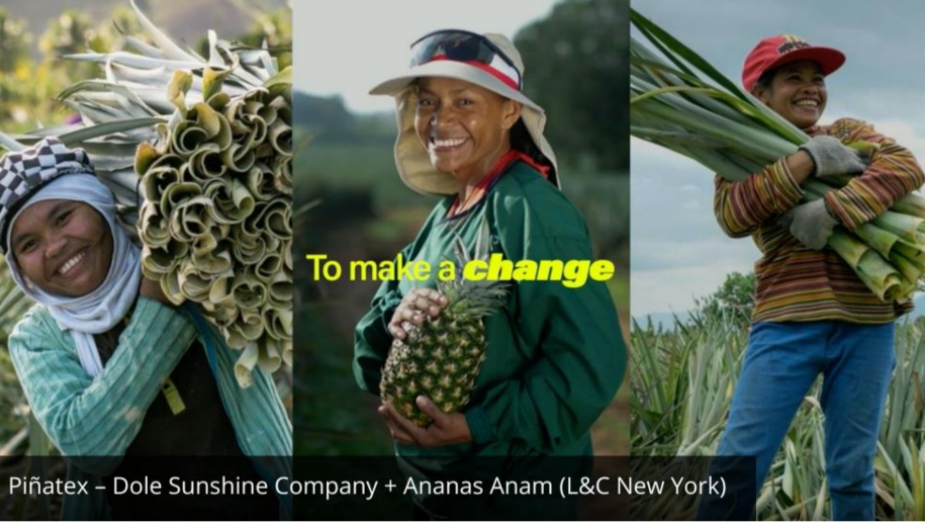
Plus a special shout-out from my company, thenetworkone, for the three independent agencies who won Grand Prix’s this year: L&C New York in Creative Business Transformation, Serviceplan Munich for Film Craft and Engine London, who won the especially prestigious Titanium GP, for the long running campaign against knife crime for the Kyan Prince Foundation.

The last mentioned was created by Engine’s PR division, MHP Mischief – an odd coincidence of names with New York based Mischief @ No Fixed Address, which did not win a GP but did well on stage, in other awards and is sweeping the board in the US currently.
Perhaps a hint as to exactly what has been missing from last year’s work – a sense of mischief, which is the foundation of a lot of great creative thinking.
Let’s have more mischief (from everyone) next year!
Other themes
And now let’s turn to some other themes from this year’s Cannes: on the stages, in the awards, at the parties and around the semi-official events which you don’t need a delegate pass to attend.
Today’s Creative Zeitgeist
So, what is driving the best creativity right now – and for the next few years?
Two fascinating seminars looked at this theme from different directions.
First, we had Ryan Reynolds, Hollywood star (he played the lead in “Deadpool”) and part time agency Creative director, in partnership with MNTN. I missed his big show in the Palais but caught his more conversational number at the Wall Street Journal’s “WSJ House.”
He has coined a memorable phrase: “Too much money, and too much time, are the enemies of creativity.”
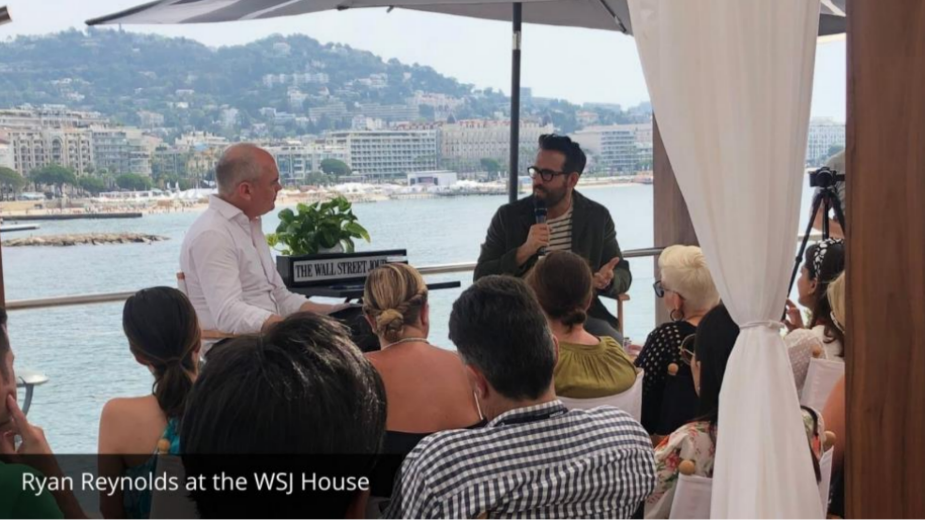
In a world that moves ten times as fast as ten years ago, and craves sustainable, accessible creativity and a work environment open to all comers – wow, does that not resonate?
Later in the week, we saw Wieden + Kennedy’s on-stage discussion with McDonald’s – a huge win for the agency, from an iconic global brand that is also seeking to move with the times. As honest and as revealing as Colleen de Courcy’s showpiece interview with Phil Thomas, but in a different way.
Wieden (and their client) didn’t just tell us what they had done right, they also told us what they had done wrong. Wieden assumed that because McDonald’s is a BIG, GLOBAL brand, they wanted a BIG, GLOBAL campaign. Meeting after meeting, they presented BIG, GLOBAL ideas but the client didn’t feel comfortable with any of them.
Finally, they went back to McDonald’s most regular and frequent customers, and asked them what made them that way. A surprising number revealed that they had their own favourite ways of customising the famous sandwich. This was as true of iconic celebrities as of regular John’s and Jane’s. So the search for the BIG IDEA was abandoned, and the campaign became one of multiple small vignettes of famous people’s favourite way of eating the sandwich. It worked, the client bought it and is now lovin’ it.
So what went wrong with Creativity in our industry?
Somewhere along the line, the momentary flash of insight or inspiration which is the essence of the greatest creativity, became defined as “the BIG idea”. And BIG drove SCALE which drove ACQUISITION and CONSOLIDATION and the creation of industrial creative factories where most employees don’t know who the other people in the building actually are.
Let’s all think about that; including the Holdco bosses who are stuck with the philosophy that bigger is better, because their growth-centred business model depends on it.
Jay Chiat famously said, “How big can we get before we become bad?” and in the spirit of scientific enquiry, sold his agency to Omnicom (the name says it all) to find out.
Don’t get me wrong. Big has a place. Big data (and processing power) is driving scientific advances all over the globe. But data analytics is a craft skill, not the same at all, as original creativity.
As Andy Hopkinson, strategic director of Extreme Reach, which delivers and processes 80% of creative commercial content to TV stations and servers across the US and beyond, said to me last week: “You guys [the independents] are in the right place at the right time.”
Purpose fatigue
Not wishing to repeat what’s already been said: but we need less talk about purpose next year. Of course, a corporate purpose has a value: it helps a company define what it should or should not be doing; and to attract, engage with and retain talent. But ultimately – as we have said here before – a corporate purpose is fundamentally self-serving. Companies might do better to think about what they can contribute to society. ‘Ask not what America can do for you, but about what you can do for America.’ Making a contribution, rather showing off, is a key part of Gen Z values, as illustrated by Edelman’s new report which was being trailed at Cannes. The pandemic brought this home too: the value of collaboration, rather than a race to corporate glory, was a huge learning from the experience that will have shaped a generation of young people.
Buy, command and control is still a frequent strategy in our industry, from traditional holdcos to new players like Accenture Song. If we want to keep our relevance in the decades to come, maybe it’s time for a reset.
As Jackie Cooper, founder of one of the best PR firms, put it: ‘we are going beyond purpose to action and activism.’ Perhaps it’s ironic that Greenpeace blocked the road by the Palais and invaded (or conducted a special non-military operation on) the WPP Party beach, apparently at the very moment when one of WPP’s agencies was collecting a Cannes Lion for their work on.. yes, you guessed it.. Greenpeace.
Stay agile, campers..
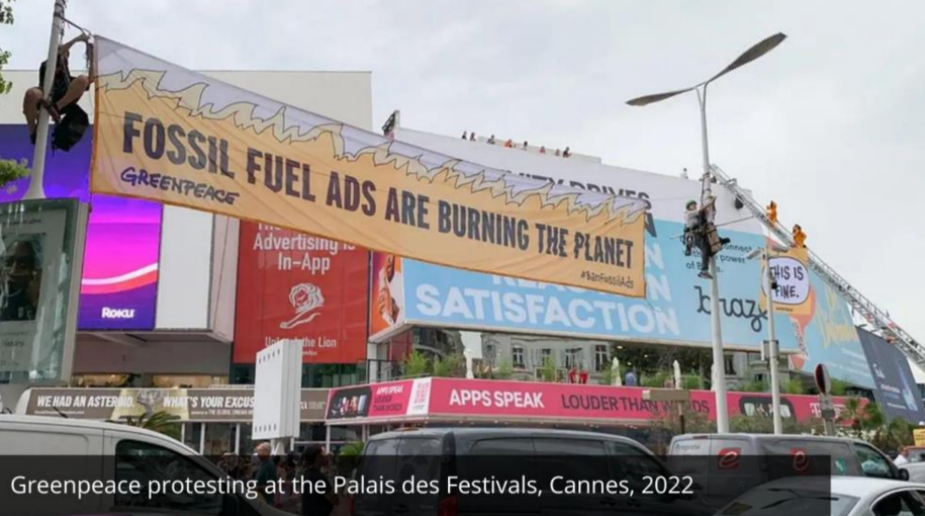
Crisis in the Marketing Department
Traditionally, an agency’s clients were Marketing Directors and CMO’s. The awards show that some of an agency’s most valuable contributions extend much wider within their clients’ organisations. We’ve all seen the erosion of ‘Marketing’ as part of a job title, as Customer Experience and Data Science take centre stage, but there is more to it that this.
In the week before Cannes, I was also fortunate enough to attend ProcureCon, Europe’s leading conference for Marketing Procurement people.
Procurement gets a bad rap in Cannes from the leaders of the business which used to be called A*********g. Luminaries like Sir Martin Sorrelll and Paul Bainsfair see them as cost cutters first and last, reducing price and therefore also quality and commitment.

Speakers at ProcureCon took a different view. Mark Evans, CMO at Direct Line insurance in UK, talked about the first year in a CMO role as being the survival period – if you don’t get quantifiable business growth results in the first year, you are dead in the water. And even if you do – the average job tenure of a pre-pandemic CMO was somewhere between 16 and 22 months.
Whereas Marketing Procurement professionals typically spend eight to ten years with a company. The consequence being, they have a longer term view – and a greater capability to set, drive and evolve marketing strategy.
Agencies really need to wise up to this.
Procurement controls a client’s supply chain. Today, a better, more efficient supply chain is a crucial advantage in global commerce. It is said that P&G’s current outperformance of Unilever and other competitors is more due to better supply chain management, rather than their traditional marketing orientation of demand creation.
And today, with AI increasingly taking over control of demand generation from the ‘colouringin department’, agencies seeking long term, strategic relationships are increasingly seen as part of the supply chain.
And what do clients WANT from their supply chain? Robustness and reliability; speed and agility; innovation; cost efficiency; diversity and social responsibility.
Agencies that have not upped their game on DE&I had better watch out. A major global creative pitch in the US this year was won by the agency with the most diverse team.
A well-known, award-winning PR agency in New York, told me of a client who walked out of a key meeting and refused to return until the agency brought in people of colour to join the discussion.
Most of all, agencies need to up their game in basic business skills.
Mark Read’s comment at a WSJ seminar in Cannes, was especially revealing:
“In pitches, the client typically picks their favourite idea and then there is an arm-wrestle over price.”
This explains why WPP’s long term profit margin is less than 50% of what Accenture and other consulting firms achieve. Will they continue to achieve that, while bedding in a bunch of leading a*********g agencies and changing their name to Accenture Song ☺? It will be fascinating to find out.
Geopolitics
Ukraine may be “The West’s issue” in the eyes of much of the world, but it was good to see the festival giving genuine attention to the current crisis in Ukraine and the opportunities to help its victims.
Well done to Cannes Lions for offering free passes and award entries to Ukrainian Marketing and Communications professionals. And to organisations like the PRCA / ICCO PR Agencies associations for holding events for them to be heard.
We at the networkone were also pleased to be able to give a platform at our Indie Forum to Nataliya Popovych of One Philosophy, an indie PR agency group in Kyiv, who shared many critical strategic insights; and to Olga Lanovyk of indie creative agency Tabasco, also in Kyiv, who shared her experience as a normal agency person, waking up to the sound of bombs falling around her and spending the next few weeks sheltering with fellow-citizens in an underground bunker and then fleeing for her life with her pregnant neighbour. It’s great to see that while we all hold divergent views on many issues, we can collectively draw a red line where we really must.
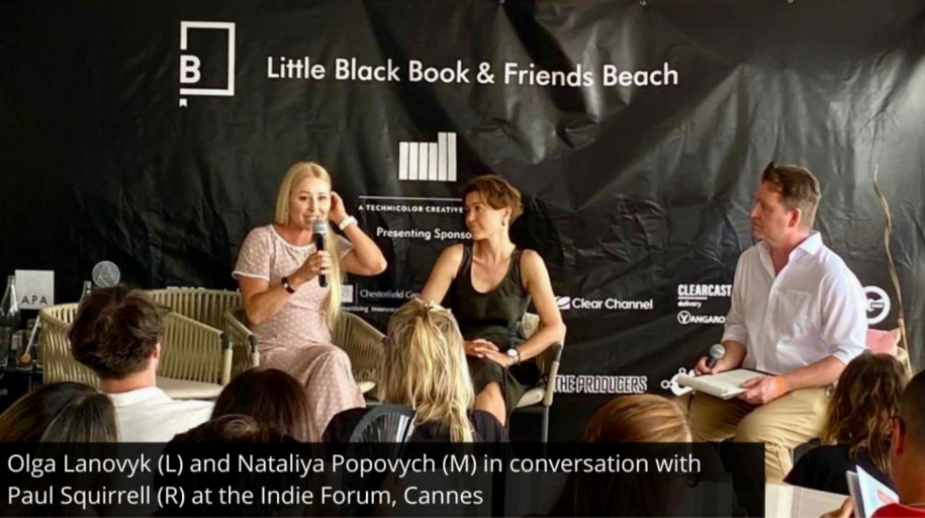
Back at the WSJ house, one of the best sessions I attended was the Q&A seminar mentioned above at the Wall Street Journal’s WSJ House, where one of their writers interviewed three of the holdco chiefs simultaneously: Mark Read (WPP), Philip Krakowski (IPG) and Wendy Clark (Dentsu International).
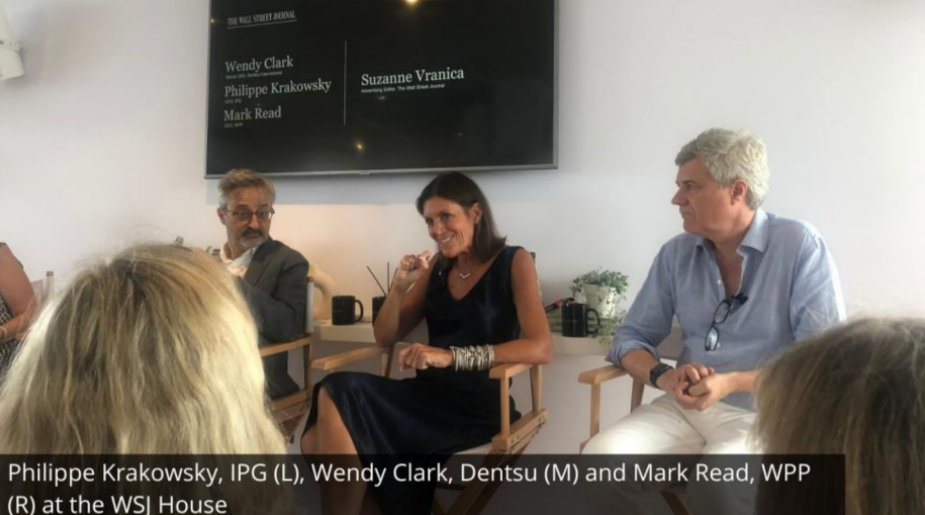
From the back of the room, Richard Edelman – CEO and owner of the world’s largest PR agency, which bears his family name - asked where they would draw the line on working with certain regimes. Russia today, China tomorrow?
Mark Read’s answer was unequivocal: WPP has withdrawn from Russia, but has no plans to withdraw from China. It’s just too important – not only for them, but also for their clients. Neither of the other two demurred.
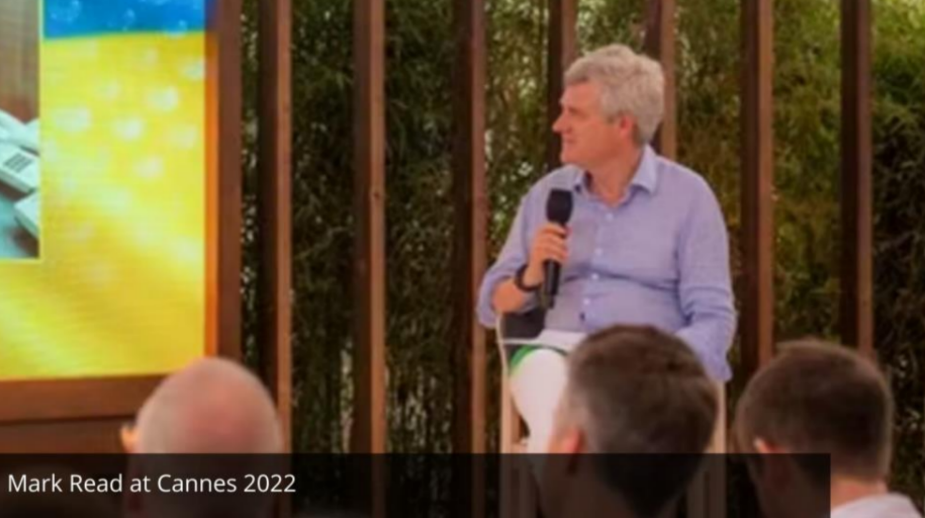
More on the holdcos
This year, the holding companies were relatively quiet on the main stages. The exception was Dentsu, who used the occasion to announce the launch of the new identity of their International Division. There were some nice (and very Japanese) monochrome graphics of animals symbolising the agency’s qualities:
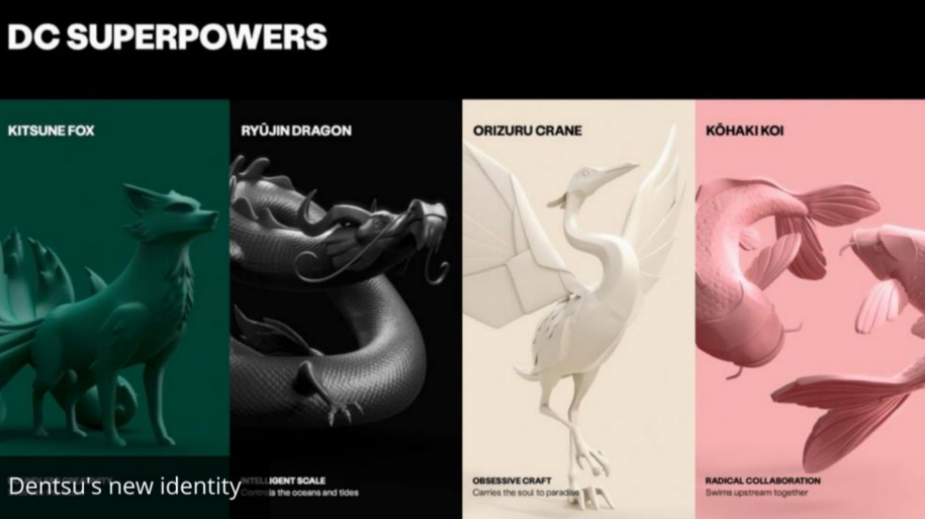
- A Kitsune Fox: to see the future (creativity)
- A Rinjin Dragon: to control the oceans (scale)
- An Origami Crane: to develop craft skills
- A Kohaku Koi carp: to swim upstream.
Nice, but hardly ground-breaking. And finally, the big reveal of the agency’s new name: “Dentsu Creative”. Wow.
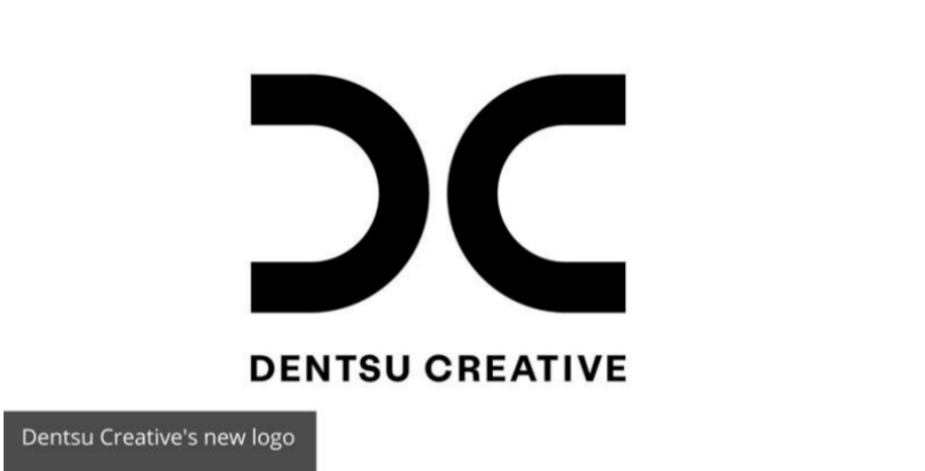
So all the Group’s non-Japanese creative agencies are being merged together and media will be kept separate? Probably just a step on the agency’s journey to be “the most integrated agency.”
Creatives will (say Dentsu) be able to jump from making TV ads to TV shows. That team in Mumbai will be writing your next Superbowl ad, without passing Go and collecting some culturally relevant experience. All very nice on paper, but whether or not it would work, this plan is disqualified for excessive use of the A-word.
Meanwhile, Dentsu’s highly diversified, non-global setup in Japan ploughs its own path and continues to deliver enormous profits.
I’m sure Wendy Clark is well-paid, but I doubt many of us would envy her job. Adam Ferrier may have been a bit unfair to call it a shit-show, but you can kind of see why he did.
And on new agency models?
This is an interesting area for several reasons.
I was hoping that Cannes 2022 might look seriously at the opportunity for smaller non-holdco agencies, to plug in where needed, to Clients’ in-house agencies. In-housing isn’t going to go away, as clients control the first-party data which is today’s currency of choice for anything to do with marketing and communications. These in-house agencies won’t be rushing to replace themselves with all the people WPP wants to send in, to replace them at 2x the cost.
But indie agencies and specialists to plug in when needed? Yup, that’s interesting. Some people might see this as competitive to independent agencies: we don’t. We see it as complementary.
What did get talked about, was the increasing viability of using freelance talent to chip away at the agencies’ monopoly on commercial creativity. Amir Guy of Togetherr, an offshoot of Fiverr, told us why this was so attractive:
“We stuck to our large teams and long processes. We added tech and we added data.. but our creatives exited.” Professor Scott Galloway of NYU describes us as a dying industry.
What is significant though is that technology is transforming the freelance creative sector to the extent that it is actually useful to large international clients. Companies like Fiverr, Vicoland, Talenthouse and others are following in the steps of influencer agencies like MG Empower and providing ‘oven-ready’ custom-built creative and production teams, from bestin-class individual practitioners
Because creativity IS much more fluid now.
Amir’s seminar also introduced us to:
- Eva Santos, who left her job as a network agency CCO for a start-up with two people she had never met IRL because she wanted to work alongside “alchemists, not distributors”
- Karin Onsanger-Birch, who left her role as CCO of FCB San Francisco for a client-side position at ride-hailing firm Lyft, because “here, I can pull in all the best creatives” and
- Greg Hahn, who left BBDO and started Mischief, the hottest agency in New York right now.
I’m less convinced about Per Pedersen. He says the on-trend things about agencies being owned by creatives not CFO’s, but if he really thinks that, why did he work 30 years for WPP? My jury’s out on that, but there are a LOT of other examples of alliances and project teams being built and disbanded much more fluidly, in Europe and Africa as well as the Americas. Check the relationship between Jung von Matt in Germany and 180 Heartbeats in Poland, for one example.
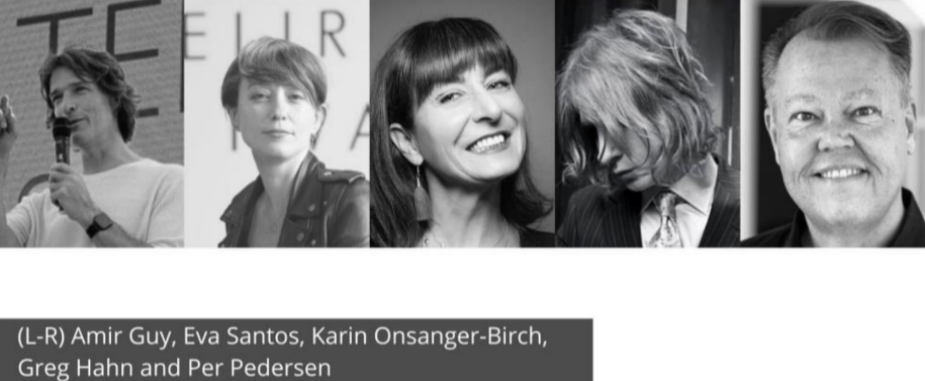
As Michael Trautmann used to say, “Friends, the best is yet to come.”
There is still work to do
For sure, that’s true.
R/GA led a seminar telling us how the point of the metaverse, is identity fluidity: a fascinating idea and very on-trend, even if it wasn’t entirely clear how actual users would achieve this.

Some US and European MNC clients who applaud the courage of Ukrainian agencies, need to get around to paying them for work they already did before the war.
Colleen de Courcy, the retiring Global CCO of top indie agency Wieden + Kennedy gave an impressive and shocking account of the challenges she faced, since Dan Wieden appointed her to the role (partly) because she was a woman – and showed a film where an all-singing, all dancing female cast explained that talking about female empowerment was all very fine but what they really wanted was more money.

And the Cannes Lions?
They deserve our thanks and our appreciation. The speaker program might have been a little shorter and thinner than usual, the stars stayed away (remember when we had Bill Clinton, Kanye West, Anna Wintour..) the creative work wasn’t always great and due to continuing quarantine and visa issues, the fifty percent of the world represented by APAC and Africa was conspicuously absent, from the stages and from the awards list.
And we will need a better story next year, to persuade delegates over 30 to part with €3,500 Euros to get into the Palais, for talks which are broadcast online a few hours later, where the Q&A is censored via the ghastly impersonal Slido app and the live speakers on the main stages are whisked out through the artists’ entrance before you can get to talk to them.
And perhaps, like Dentsu, they need to change their logo – yes, the Lion which everyone wants to win. Because at the end of the day, a Cannes Lion (with its mane) is clearly a male lion; and male lions are mostly known for making a loud noise and then sleeping in the sun, while the female lions go off and get the dinner.
But hey – they did this all under near-impossible travel and logistical circumstances, with ridiculously short lead times .. and put on a fabulous event.
Everyone I spoke to was REALLY glad they had put in the effort to make it to the South of France. Including the people from Australia and New Zealand who took four separate flights just to get there.
So well done Phil, Simon and all the gang. Count me in for next year.











